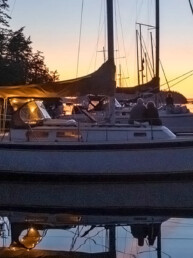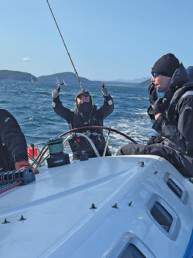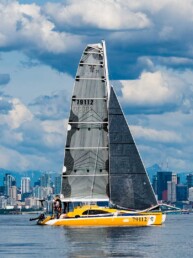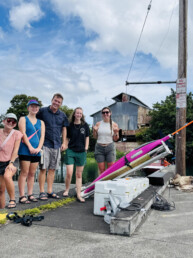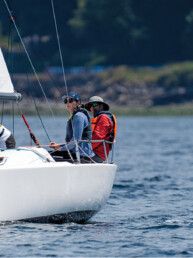This article was originally published in the September 2021 issue of 48° North.
The whole adventure started with a call from my friend Mark Harang on a Friday night asking what I knew about sailing Beneteau 40.7s. Hadn’t I put in some miles?
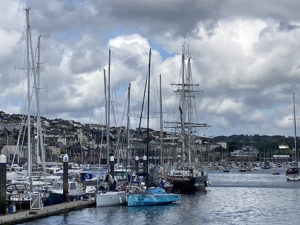 Why, yes! I certainly have.
Why, yes! I certainly have.
Mark told me that our friend and renowned offshore navigator, Brad Baker, had an opportunity to join a crew on the Fastnet Race with some local sailors that had already set up a charter. I was super excited for them and happy to share whatever I knew. It didn’t take long for Mark to share that they were actually looking to add one more crew, and wondered if I was interested. Of course I was!
As I write this, I’m sitting in the French countryside after the race finish party for Fastnet 2021, and I wonder where to begin and end? So much to share. Here are some of the happy bits that come to mind from this PNW-based crew’s first Fastnet attempt.
The Fastnet Race
The Rolex Fastnet Race is the biggest race in the world, based on the number of entrants. This year’s event had nearly 500 boats sign up, with everything from Beneteau 40s to Volvo 70s to the singlehanded IMOCA 60 fleet with Alex Thompson on Hugo Boss, to Rambler 88 with a crew of 26 sailors, down to a handful of boats just big enough to meet safety requirements.
The Fastnet starts in Cowes on the Isle of Wight and takes the various fleets upwind along the cliffs of southern England, across the Celtic Sea to Ireland, where you round Fastnet Rock on the southwest shore. After making the turn at what’s known as the “Teardrop of Ireland”, the course traditionally sends racers back to Plymouth, England for a total of 600 miles. The race has historically been dominated by French sailors, and this year the finish was a run to Cherbourg, France, along the shores of Normandy. Finishing in France added another 95 miles to the course, making it 695 total miles.
This is the first time the Fastnet has finished in France and it was quite a year to add international logistics to the usual challenges of huge tides and big breezes. Pandemic-era planning was as stormy as the North Antlantic system headed our way.
The Crew
Our crew was made up of nine sailors. Brad, Mark, and I joined three Russian sailors from Seattle who chartered the boat in England. Vlad, Yury, and Victor organized the group, while also helping us learn some Russian culture along the way. Crewmember Keegan Brown is a new sailor in town from the Great Lakes and owns the 40.7 Audacious aboard which we practiced in advance of the race. Our eighth crewmember, Josh, joined us from the Midwest. Our crew also enlisted a card-carrying professional skipper from Florida.
Chartering
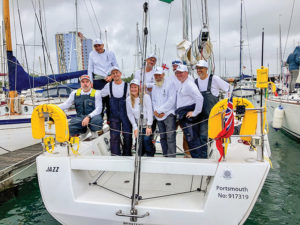 Chartering a boat with your own crew is probably the only way for most of us in the Pacific Northwest to participate in an event like the Fastnet. My best advice would be to have some of the crew arrive VERY early, and have a rigger and sailmaker lined up to help. Pro tip — make sure the boat you charter has a chartplotter in the cockpit. You will be racing in lots of wind, along an unfamiliar rocky shore with lots of shoals and there are going to be race boats all around you.
Chartering a boat with your own crew is probably the only way for most of us in the Pacific Northwest to participate in an event like the Fastnet. My best advice would be to have some of the crew arrive VERY early, and have a rigger and sailmaker lined up to help. Pro tip — make sure the boat you charter has a chartplotter in the cockpit. You will be racing in lots of wind, along an unfamiliar rocky shore with lots of shoals and there are going to be race boats all around you.
Our crew arrived at our chartered Beneteau First 40 Jazz in Gosport, England, a week before the race. Gosport is a British Navy port just at the end of the narrow entrance of the channel that leads to Southampton on the south coast of England. Portsmouth is just across the small channel. Portsmouth is much larger than Gosport, and has shops, restaurants, and museums. What Gosport lacks in creature comforts, it makes up for with lots of boats. The Clipper Round the World training boats are moored here, and Hugo Boss was just down the dock from us.
Our first impression of Jazz was shock, because the boat was torn apart when we arrived — none of the six new race sails were on board or in anyone’s possession, and we had to climb over the toilet that was laying on the dock next to the shards of the mirror from the head to get aboard. It was nonetheless an excellent boat for the course! It’s no surprise that there are so many of them in the race. There were 13 Beneteau First 40s in the Fastnet, and I think 7 Beneteau 40.7’s. Jazz got put back together in short order.
Looking back, it’s advisable to arrive at least two weeks before the start. Everything aboard Jazz needed to be inspected and taped, many lines needed to be re-led, and the cabin area needed to be prepared for the demanding conditions ahead. The sails running behind schedule is probably typical given that Fastnet is just after Cowes Week, which was going on while we were setting up the boat. The plan was to haul out the boat, but the dry dock was not operating, so we hired a diver instead. One week was really not enough time to rig, provision, and practice. We had more chores than days to complete them.
Getting out to practice was the fun part. We got to cross tacks with the likes of Rambler 88, and sailed down to Cowes to watch some of race week. Cowes is across the Solent from Gosport and Portsmouth. By the time we were sailing, everything was working well and we had a great coach to work out the kinks.
Provisioning
I had a lot to learn! Normally, on-board cooking involves a small space that is lurching around. And then there’s the Fastnet, where you’re trying to fix a hot meal while going directly upwind in 30 knots all day and night. The crew is eating while holding on, with waves breaking over their heads. That being the case, I can say avoid the gravy, for obvious reasons, and skip the plates as well. We were only able to eat whatever we could hold in one hand that was impervious to the occasional wave — apples were a favorite, and you can’t have too many granola bars.
The Start
 As race day approached on Sunday, August 8, a system came in with 25 to 30 knots of wind. We were still waiting on our race jibs, and the breeze was above the range of the new kites on board. We used the time to work out navigation and weather tracking. On Saturday morning, we still had last minute chores securing bunks, water, food, anchors, and gear. In the afternoon, we took the ferry to Cowes for the skippers meeting; a surprisingly circuitous route via two ferries and three buses each direction. Cowes is a fantastic sailing town. Fortunately, the jibs arrived that night.
As race day approached on Sunday, August 8, a system came in with 25 to 30 knots of wind. We were still waiting on our race jibs, and the breeze was above the range of the new kites on board. We used the time to work out navigation and weather tracking. On Saturday morning, we still had last minute chores securing bunks, water, food, anchors, and gear. In the afternoon, we took the ferry to Cowes for the skippers meeting; a surprisingly circuitous route via two ferries and three buses each direction. Cowes is a fantastic sailing town. Fortunately, the jibs arrived that night.
It was hard to sleep the night before the race. I took my Scopalomine and worked on boat chores until 11:00 p.m. The breeze was still on, and was showing no signs of backing off.
Sunday morning, we woke up early. Coffee and toast got us going, but we couldn’t help thinking about the rough ride that would ensue over the next 24 hours. We were all well warned at the skippers meeting and had seen the forecast for ourselves.
Fastnet organizers require that all boats pass through pre-start gates with storm jibs, tri-sails, and storm numbers. You have a choice of three different gates, and they are a bit hard to find in a sea of race boats and rough water. In the end, it was good that the storm jib was required because it was the right sail. We started the race with two reefs and the orange storm jib in 30 knots of wind.
The start line of Fastnet is very interesting. The pin end is a flag in front of the castle of the Royal Yacht Squadron. Actual cannons line the front of the yacht club and are used to mark each start. There’s a VERY bright light on the flag, and you can see it on the left side of the flag when you are on the proper side. The light disappears completely when you are on the line. You see it again when you cross the line, on the right side. The boat end of the line is a channel mark. There is a Race Committee boat at the boat end, but it makes no effort or claim to be on the line. The boat is the outer limit from shore but not on the line. Very confusing, especially in rowdy conditions and close quarters.
We were in the IRC2 division and supposed to start third. At the skippers meeting, they moved our start to the end. A good thing about that was the tide had changed to our favor by the time we started. We could see some of the earlier starts, but mostly stayed out of the way.
On board Jazz, we were very cautious about the tide pushing us down over the line. We took a conservative approach and, while it was not intuitive, it was successful to stay out of the trouble farther down the line.
The Solent
The Solent is the first thing that you will hear about when you ask about the Fastnet race. It’s similar to Puget Sound in that it’s the protected waters inside the Isle of Wight. There are deep bays and river outlets. The race starts on the Solent and it takes a few hours in good breeze to get out to the open English Channel. There are many ships in the Solent and you have to mind the shipping lanes. On the west end, you exit the Solent in a narrow passage by the Needles on one side and a long peninsula with a fort on the other. The Needles is quite an impressive rock formation that extends from the last point of the Isle of Wight. The south coast of England is beautiful — rocky with shoals and sea cliffs. Farms border the cliffs, and villages are nestled into the bays and coves.
The Solent gave us a slog upwind in heavy air and big waves. It made sense to stay out in the positive current, but there was some advantage to staying in the calmer water close to shore. We played the edge of both and made great progress on our fleet, pointing well with good boatspeed. Some boats elected to have comfort and had dodgers that they could hide behind. Conversely, we hiked on the rail and were never dry again.
We thought the swells were big in the Solent, but once we turned the corner at the iconic Needles it only increased. Out in the channel, the waves were at a better angle on starboard and we endeavored to stay on the favored tack, making solid gains all day. Being in the last start, we didn’t cross the line until 12:40 p.m. and had the afternoon to get our bearings before darkness fell.
Keel Bolt Complications
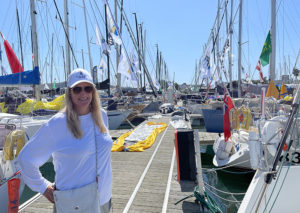 Sailing in the dark in big breeze along an unfamiliar shore with boats all around was a new experience. We were wet and tired and, as soon as we went below, we felt seasick. On board Jazz, we had a lot of water on the cabin floor, which we bailed because the pumps weren’t doing much. We attributed it to the angle we were sailing, and we dumped buckets for most of the night. To make matters worse, the chartplotter stopped working and the digital compass on the mast gave up, all likely due to water in the system.
Sailing in the dark in big breeze along an unfamiliar shore with boats all around was a new experience. We were wet and tired and, as soon as we went below, we felt seasick. On board Jazz, we had a lot of water on the cabin floor, which we bailed because the pumps weren’t doing much. We attributed it to the angle we were sailing, and we dumped buckets for most of the night. To make matters worse, the chartplotter stopped working and the digital compass on the mast gave up, all likely due to water in the system.
We were down to reading off compass headings back to the driver and navigating by the Navionics apps on our iPhones. Not ideal, but we made it work. Nobody had anything dry, and the nav station had water up to the top of the navigator’s boots. The wind settled down to 20 knots in the early hours of the morning and we swapped out to the #3 and shook out a reef.
By daylight, it was becoming a perfect ocean day. The sun was breaking through, the sea cliffs were beautiful, dolphins came along, and we could see what we were up against. We were still pumping water and dumping buckets, but the boat was moving along nicely. It was time to get to the bottom of the water situation. The anchor locker seemed like a solid culprit to me. It was taking a lot of water and had to be a sizeable opening.
Meanwhile we had Lizard Point, Lands End, and the Scilly Islands in our sights. This was a major navigation point of the race. After passing Lands End, we’d be on the open stretch across the Celtic Sea to the Fastnet Rock. We had GRIB files more often and we were sure that the water
problem would be solved.
After testing every other theory, we moved everything off the floorboards in the main salon. For safety, we had put the anchors and extra water over the keel. We put sails and gear bags over that. Once everything was removed, including all of the water (requiring three pumps and a lot of buckets), we reached the bottom of the bilge. Water was pouring in around the keel bolts. We briefly discussed whether we could try to keep up with the water now that the seas settled and we knew the source. In the end, it was not worth the risk. Worse things could happen, so we made the decision to abandon the race and head for Falmouth, which was the closest port. It was not the adventure that we expected, but it was the adventure we got!
It turns out the keel was new and not factory installed. The boat was recently in the Sunsail charter fleet and almost all cruising boats in the Solent have shoal keels because of the extreme tides and shallow water. Our new keel had a sea trial, but not in 30-plus knots with the seas we experienced.
Could anyone have known that the keel bolts were going to fail? Could we have continued? We aren’t sure, but we made the best decision.
Other Highlights
The fast boats were simply unbelievable. Crossing jibes with Rambler 88 during practice was mind blowing. It’s incredible to spend time just enjoying the details that go into a boat like Hugo Boss — one foil alone is worth more than my home. The multihull Maserati has hydraulic foiling rudders. It’s inspiring to see some of the fastest and most advanced sailboats in the world right there in front of you!
Both England and France were charming! And beautiful. And full of history and a genuine love for sailing. I have felt completely embraced as an American, and never knew I had such a great Canadian accent.
The drink of choice? Gin, of course! In every imaginable flavor.
Fastnet Rock
So, we never got to see Fastnet Rock on this trip. Future goals!
In the end, the whole experience was well worth the effort. The race didn’t work out perfectly as planned, but we made lots of lemonade out of the lemons. Opportunity leads to more opportunity. Just say yes, you’ll figure the rest out along the way! A fabulous adventure is, in itself, a great reward.
Stephanie Campbell
School teacher by day, rad racer by night and weekend, and 48° North's lead racing reporter in between—Stephanie Campbell of Anacortes, WA, is one of the Salish Sea's most respected sailors. Her trophy wall is jam-packed and includes a Santa Cruz 27 National Championship. She's the proud owner of SC27, Wild Rumpus, and Martin 24, Area 51.


